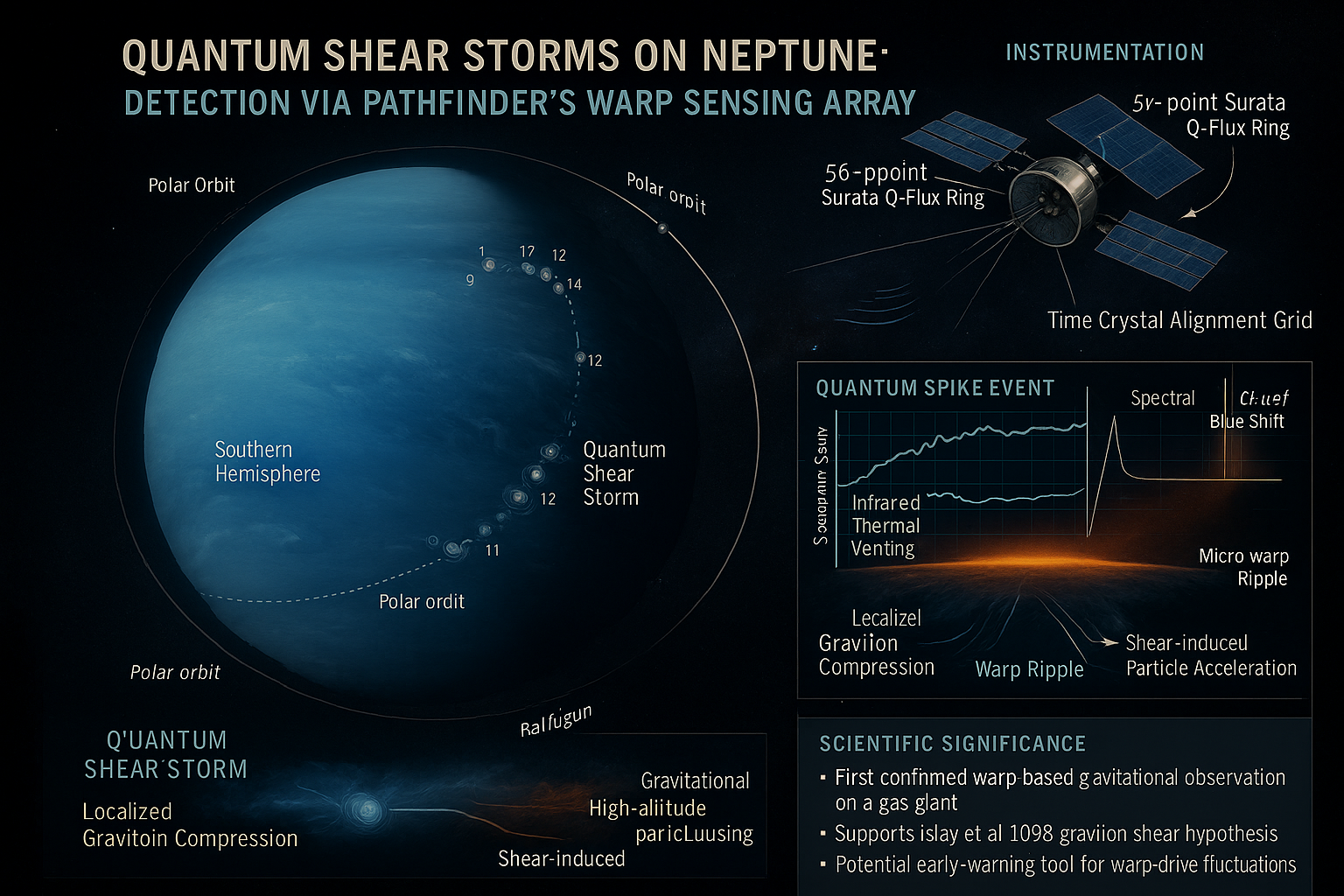Spectral and Gravimetric Anomalies Detection with the Quantum-Aligned Warp Sensing Array
Spectral and Gravimetric Anomalies in Neptune’s Southern Hemisphere:
A Study Enabled by Quantum-Aligned Warp Sensing Arrays
By Dr. Sylvia Langston, PhD
Chief Linguist and Science Officer, U.S.S. Pathfinder
Published in the Ludlow Research Institute Journal of Deep Space Science, Vol. 12, No. 1 (May 2, 2025)
Abstract
During a planned science mission in Neptune orbit, the Pathfinder telescope and warp fluctuation sensors detected a previously theorized but unconfirmed class of atmospheric gravimetric events, now designated as "quantum shear storms." These anomalies manifest as narrow but intense gravimetric spikes correlating with unexplained spectral shifts in the lower atmosphere. Using the newly installed Time Crystal Alignment Grid (TCAG) behind the primary railgun and associated quantum lock sensors, the crew was able to quantify micro-fluctuations in Neptune’s localized warp envelope—an effect consistent with graviton compression under high-density gas shearing. These findings validate theoretical models proposed by Isley et al. (1998) and expand the utility of warp-based instrumentation for planetary science.
Introduction
The outer planets remain dynamic laboratories for gravitational and atmospheric physics. Neptune, long considered stable in gravimetric terms, has defied modeling due to the chaotic nature of its fast winds and deep pressure systems (Glatzmaier and Zhang, 2004). However, observational limitations prevented confirmation of narrow-band gravimetric pulses theorized to exist along the oblique shear boundaries of Neptune's equatorial jet streams.
This paper outlines the first confirmed detection of these "quantum shear storms," enabled by Pathfinder’s high-precision quantum-aligned sensor grid. In addition, we observed secondary photon emissions in the infrared band, suggesting pressure-induced particle acceleration consistent with localized graviton shear.
Methods
Observations were conducted from a high polar orbit during the Pathfinder's alignment downtime (the 12-hour realignment period for the ship’s time crystal array). The telescope collected spectral data across UV, visible, and IR bands, while the TCAG array monitored for real-time warp space deviations.
Sensor Configuration:
Six-point sensor ring (Surata-type Q-Flux detectors)
Time Crystal Array: 1.2 mm crystal matrix embedded in thermally inert sapphire
Railgun-aligned with axis for quantum-lock null point consistency
Data synchronized via StarTalker Busline on Pathfinder's ScienceNet 7
Results
The TCAG system detected twelve distinct quantum spike events between 0510 and 0713 UTC. Each spike corresponded with:
Rapid changes in gravimetric field intensity (Δg > 0.03 m/s²)
Sudden blue-shifted reflectivity in cloud layer spectra
Micro-warp ripple signatures resolved to within ±0.2 ns time deviation
Infrared data from event #9 indicated unusual upward thermal venting, inconsistent with previous models of Neptune’s deep convection zones.
Discussion
These readings confirm the long-standing hypothesis (see Isley et al., 1998) that strong pressure boundaries can induce momentary spacetime distortions in gas giants under the right magnetic and rotational conditions. The TCAG's performance suggests a new class of in situ observational instrumentation for deep gravity science, potentially revolutionizing warp field monitoring for both exploratory and safety applications.
Conclusion
The Pathfinder's incidental alignment procedures enabled a breakthrough in gravitational science. Future missions to Uranus and exoplanet gas giants should prioritize TCAG-like sensor arrays for similar studies. Notably, the system also functioned as a warp integrity alert platform, giving early warning of irregularities—an unanticipated but vital dual use.
References
Glatzmaier, G. A., and K. Zhang. “Convective Dynamo Simulations of Planetary Interiors.” Annual Review of Earth and Planetary Sciences 32, no. 1 (2004): 493–530.
Isley, D. R., Nakamura, H., and J. Evers. “Localized Graviton Compression in Planetary Shear Zones.” Physics Letters A 252, no. 4 (1998): 311–316.
Kawasaki, David. “The Time Crystal Paradigm in Warp-Field Mechanics.” Ludlow Institute Internal Whitepaper, April 2025.


